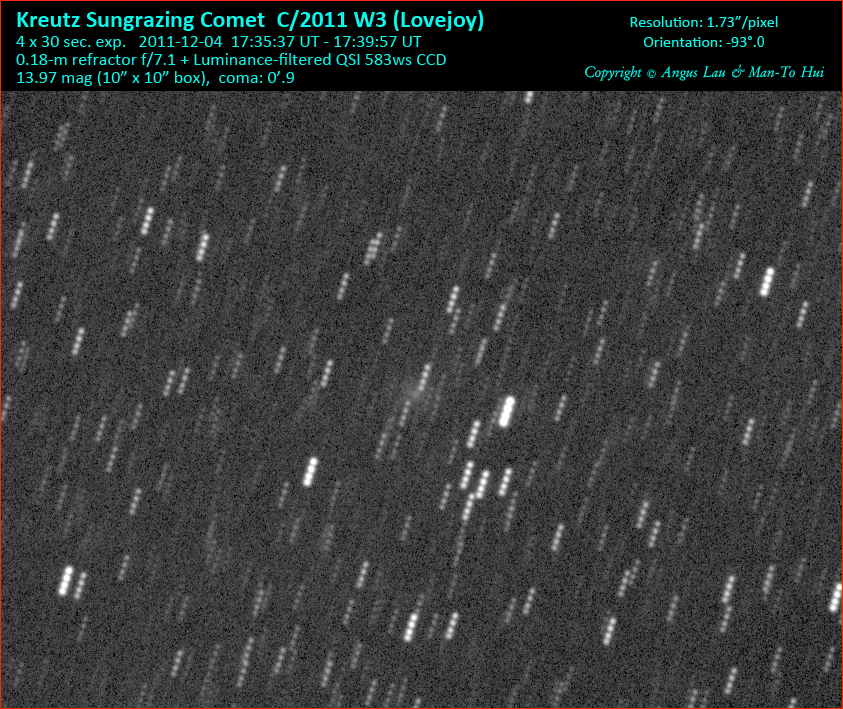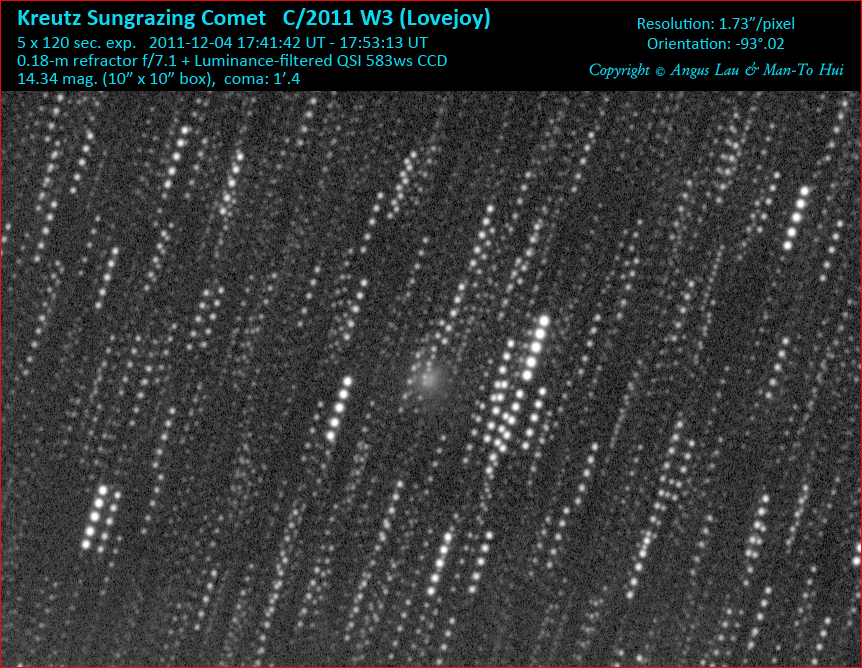Kreutz Sungrazing Comet
C/2011 W3 (Lovejoy)
2011/12/04
CBET 2930, issued on Dec 02 2011, announced
the discovery of a new comet of 13m by Terry Lovejoy from Thornlands,
Australia, on three images taken each on Nov 27.7 and Nov 29.7 UT, through
a Celestron 0.20-m f/2.1 Schimdt-Cassegrain reflector + QHY9 CCD in the
course of his normal comet-search program. The comet appears as a clearly
diffuse circular object with an approximate 1' coma in diameter. The central
condensation is of around 16m and no tail is seen. T. Lovejoy found
that the comet had increased in brightness by around a magnitude and the coma
turned well-condensed by Dec 1.7 UT. The new comet has been designated C/2011
W3 (Lovejoy).
The most exciting aspect of the comet is that
with astrometric observations it is an inbound Kreutz sungrazing comet, which is
the first ground-based discovery of a Kreutz sungrazing comet since comet C/1970
K1 (White-Ortiz-Bolelli)! Compared to those Kreutz sungrazers observed by LASCO
and STEREO imagers, it is likely C/2011 W3 will become the brightest one amongst
them. However, since it is intrinsically faint, possibilities of becoming a
broad daylight comet as C/1965 S1 (Ikeya-Seki) and survival after perihelion
seem implausible. Anyway, it surely will convey precious information before its
final destruction to researchers for close studies. I wish a brilliant
performance within the FOV of STEREO and SOHO/LASCO cameras.
2011 Dec 04
|
Images remotely obtained from
Golden Stars Observatory, Australia, owned by Angus Lau from
Hong Kong.
Mouseover to see the version in
pseudo color.
|
|
Images remotely obtained from
Golden Stars Observatory, converted from
bin 1x1 to
bin 2x2. The comet
appears evidently trailed in
bin 1x1 images due to a longer exposure, yet the SNR of
the comet rises as a result advantageously.
Mouseover to see the version in
pseudo color.
|
The following MPC observations were compiled with
coordinates measured in Astrometrica
by UCAC-3 star catalog and photometry by USNO-A 2.0 star catalog in R band. The
first quadruplet is measured from images with exposure of 30-sec each whilst the
last quadruplet from images with exposure of 120-sec each:
- COD XXX
OBS A. Lau, M.-T. Hui
MEA M.-T. Hui
TEL 0.18-m f/7.1 refractor + CCD
NET UCAC-3
CK11W030 IC2011 12 04.73307 15 11 43.22 -49 35 51.3
13.8 N XXX
CK11W030 C2011 12 04.73398 15 11 44.51 -49 35 43.3
14.1 N XXX
CK11W030 C2011 12 04.73502 15 11 45.64 -49 35 39.8
13.9 N XXX
CK11W030 C2011 12 04.73608 15 11 46.98 -49 35 37.8
14.0 N XXX
CK11W030 C2011 12 04.73924 15 11 51.41 -49 35 19.5
14.3 N XXX
CK11W030 C2011 12 04.74144 15 11 53.73 -49 35 11.5
14.3 N XXX
CK11W030 C2011 12 04.74341 15 11 55.92 -49 35 02.7
14.4 N XXX
CK11W030 C2011 12 04.74529 15 11 58.65 -49 34 54.3
14.4 N XXX
----- end -----
 |
- PSF with one of the images
with an exposure of 30-sec.
|
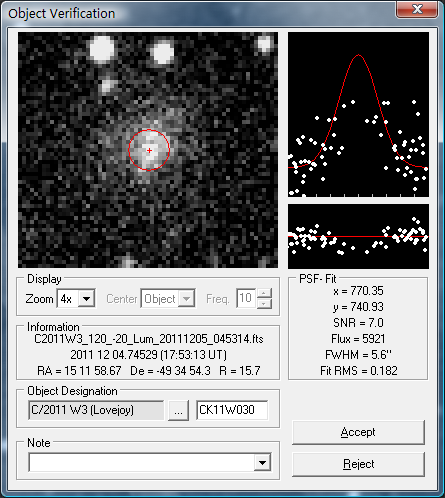 |
PSF with one of the images
with an exposure of 120-sec.
|
- Gauss curve produced by
Astrometrica with USNO-A 2.0. The total PSF is using
an aperture circle with a radius of
5-pixel around the brightest
pixel. We can see the Gauss curve
in the right is as the computed ideal line and the
real pixels contributed around the ideal line. The Fit RMS,
which inlays under the Gauss curve, is the deviation from the
ideal line. Because of the SNR being still very low both in images of
30-sec and 120-sec, as well as the fragile appearance
of the comet, the peak of ADU is merely above the noise level. The
enhancement in images of 120-sec is not as obvious as expected.
-
- Photometry result computed with FOCAS II,
which processes images based upon the .LOG file of Astrometrica, by means of
Multibox method. The first two rows are the results measured from images of
30-sec each, whereas the last two lines from images of 120-sec each.
-
- COD XXX
CATALOG: USNO A2.0 / CMC-14 - BAND:
R
10x10 20x20 30x30
40x40 50x50
60x60
SNR SB
COD
OBJECT DATE
TIME +/- +/-
+/- +/- +/- +/-
N FWHM CAT
------------
---------- -------- -----
----- -----
-----
----- ----- ----
---- ---
C/2011 W3
04/12/2011 17:37:44 13.97 12.93 12.35 11.93 11.62 11.39
4.3 16.9 XXX
C/2011 W3 04/12/2011 17:37:44* 0.09
0.11 0.11
0.13 0.12
0.13 4
5.9 USN
C/2011 W3
04/12/2011 17:48:58 14.34 13.22 12.68 12.35 12.12 11.96
6.4 16.4 XXX
C/2011 W3
04/12/2011 17:48:58* 0.03
0.06
0.06
0.06
0.06
0.04
4
5.4 USN
FoCAs II - 17/03/2010
www.astrosurf.com/cometas-obs
es.groups.yahoo.com/group/Cometas_Obs
- Interpretation of the FOCAS II table
headings:
-
-
- Fisrt line:
-
- OBJECT,
DATE, TIME: refering to their original meanings respectively
-
- 10x10,
20x20 ... 60x60: the aperture sizes of photometry in term of
rectangle in arcsec that are used to measure an object's magnitude
-
- SNR:
the Signal-to-Noise Ratio for aperture photometry
-
- SB:
stars of faintest magnitude on the images used in data reduction with
the used star catalog in Astrometrica, rather than the stars of faintest
magnitude in the images
-
- COD:
MPC Code of the observatory
-
-
-
- Second line:
-
- +/-:
precisions of measurement
-
- N:
the number of used images for measurement
-
- FWHM:
Full-Width-Half-Maximum of total PSF, relevant to degree of seeing
-
- CAT:
the used star catalog in Astrometrica
-
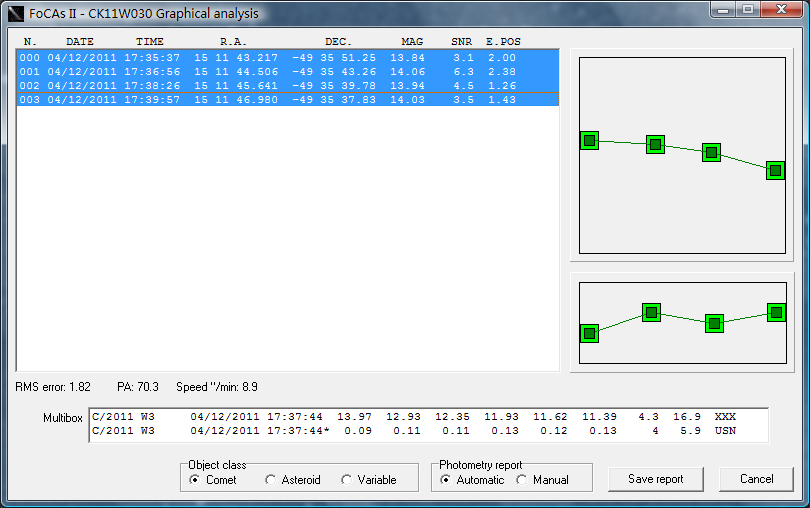 |
| Results measured from images
of 30-sec each. |
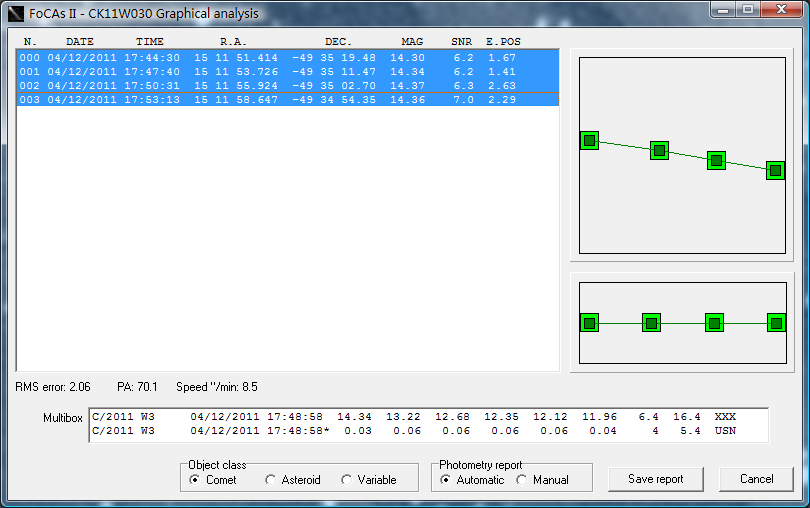 |
| Results measured from images
of 120-sec each. Obviously the residuals in photometry decrease,
compared to the above one. |
I will keep focusing on the comet. Hopefully
it can finally genuinely become a fabulous object!
Copyright © Man-To
Hui
2011/12/06
Feel free to e-mail
me with any doubts or questions.
Top
Back...
-- Zurück...
Home
